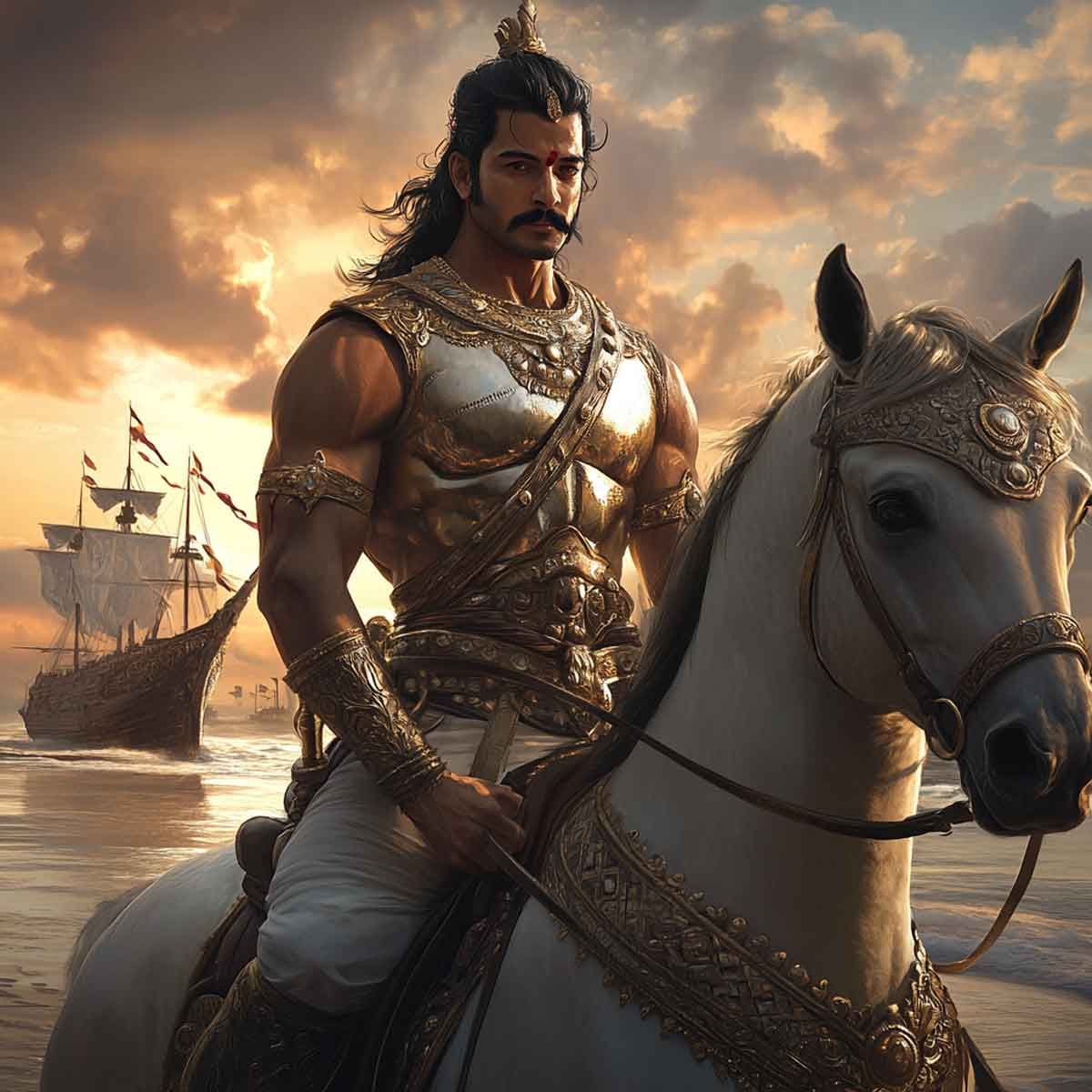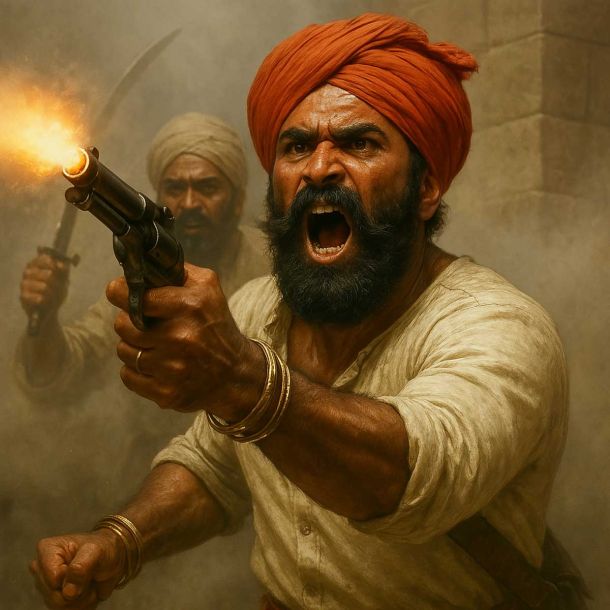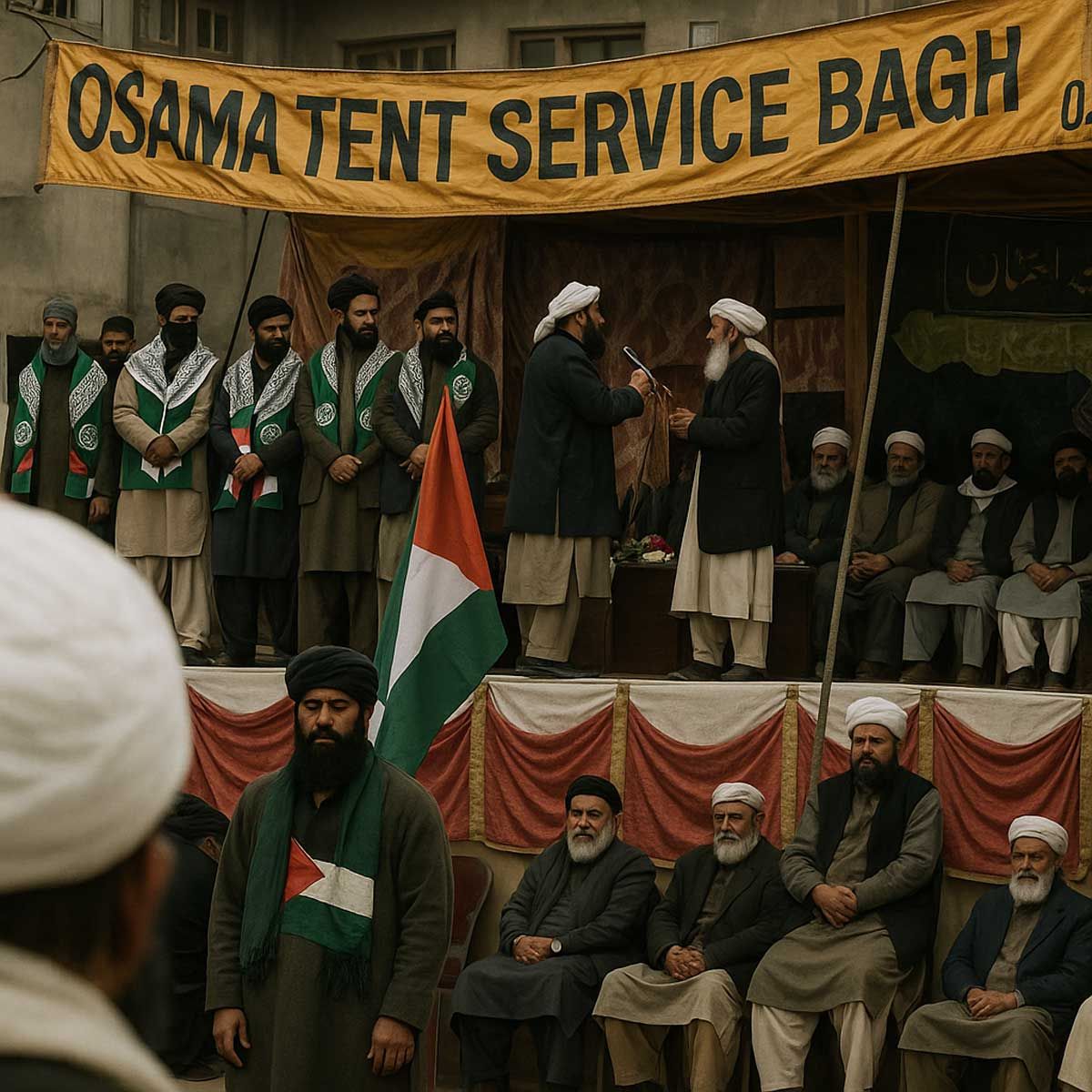Sanatan Articles
Satyaagrah
Written on
Satyaagrah
Written on
Satyaagrah
Written on
Satyaagrah
Written on
Satyaagrah
Written on
JOIN SATYAAGRAH SOCIAL MEDIA
Srivijaya, 1400 years older than Port Blair, honors a Buddhist kingdom in Sumatra & Rajendra Chola’s epic naval war, a tribute to his vision that expanded Indian influence across Southeast Asia using monsoon winds and maritime routes, a true global power

Srivijaya Puram—the new name of Port Blair, comes with a fascinating history rooted in India’s rich maritime past. By renaming the capital city of the Andaman and Nicobar Islands, the Modi government has taken a significant step towards discontinuing the legacy of British colonialism. Instead, it seeks to reconnect this historically important region with India's ancient naval and trade history. The decision, made official last week, reflects a broader effort by the government to honor India’s ancient connections. It is also part of a series of changes, as earlier the Modi government renamed three islands of the Andaman and Nicobar archipelago in honor of Netaji Subhas Chandra Bose, reinforcing a deeper connection with India's nationalist past.
|
Although the renaming was well received by most of the country, as expected, it didn’t sit well with certain groups. "Brown sepoys" and other critics voiced their opposition, labeling the renaming of Port Blair as "cartographic majoritarianism", implying that it did not resonate with the local populace. Some even went so far as to argue that the archipelago's original naming after Lieutenant Archibald Blair, a British naval officer from the 18th century, was appropriate, given its colonial history. However, these critics seem to have conveniently forgotten a much older chapter in the region's history. Long before the British Empire even emerged on the global stage, when the British Isles were still steeped in the Dark Ages, India’s Chola Empire was flourishing, not just within the Indian subcontinent, but far beyond its borders. The Chola dynasty operated a naval base in the same Andaman and Nicobar archipelago and controlled a vast maritime trade network across the Indian Ocean, dominating key trade routes and ensuring their supremacy over these waters.
The Chola Empire was not just an influential force on land but also dominated the seas. Their reach extended far beyond India's borders, as they significantly shaped and even controlled the trade routes of Southeast Asia. The Cholas’ influence over these vital routes allowed them to have a major say in the geopolitics of the region. In fact, they used the Andaman and Nicobar Islands as a crucial naval base from where they launched strategic attacks. One of their most notable campaigns was against the Srivijaya Empire, which is located in present-day Indonesia. This occurred in the 11th century, marking a time when the Chola Empire was at the height of its power. Union Home Minister Amit Shah captured this sentiment perfectly when he said, “The island territory that once served as the naval base of the Chola Empire is today poised to be the critical base for our strategic and development aspirations.” This statement not only reflects pride in India's past but also connects that history to the nation's current strategic ambitions.
Before diving deeper into the historical relevance of the Srivijaya Empire, it’s important to understand how Port Blair got its name. The city, now known as Srivijaya Puram, was originally named after Archibald Blair, a British naval surveyor who arrived in the region during the late 18th century. In 1789, Blair established a penal colony in the Andaman Islands under the jurisdiction of the British East India Company. Initially, the area was known as Port Cornwallis, but it was later renamed to Port Blair in recognition of Archibald Blair’s significant role in its foundation. This city would later gain infamy for its association with the Cellular Jail, a place where Indian freedom fighters, such as Veer Savarkar, were imprisoned by the British. The Cellular Jail stands today as a monument to India's struggle for independence and serves as a grim reminder of the sacrifices made by those who fought for the nation’s freedom.
This renaming from Port Blair to Srivijaya Puram is not just about shifting away from colonial legacies but also about reviving and celebrating the historical significance of India’s maritime past. It echoes a time when India was a powerful force in the region, with the Chola Navy representing the might and ambition of an empire that reached far beyond its borders. The renaming connects the present to a glorious history, offering a sense of pride and excitement in the nation’s cultural and strategic heritage.
|
The Srivijaya Empire of Sumatra
The name Srivijaya is a combination of two Sanskrit words: "sri" and "vijaya". The word "sri" signifies “fortunate” or “glorious”, and it is another name for the Hindu goddess Lakshmi, who is associated with prosperity and good fortune. This prefix is often used in names of people and places, much like Sri Lanka. The second part, "vijaya", means “victory”. Together, these words symbolized the strength and success of this empire.
The Srivijaya Empire traces its beginnings to the 7th century on the island of Sumatra in present-day Indonesia. Founded by Dapunta Hyang Sri Jayanasa, the empire quickly grew into a thalassocratic empire, meaning its power was largely based on maritime dominance. With control over important sea routes between China and India, the Srivijaya Empire became a formidable force in Southeast Asia. At its zenith, the empire ruled over vast territories, including Sumatra, Java, and the Malay Peninsula, establishing itself as a critical player in both regional politics and commerce. One of Srivijaya’s most significant roles was as a center for the spread of Buddhism throughout Southeast Asia, which contributed to its cultural and religious importance.
The prosperity of the Srivijaya Empire stemmed from its monopoly over the Malacca and Sunda Straits, crucial maritime passages that connected the Indian Ocean to the South China Sea. This strategic position not only made Srivijaya a hub of trade but also a melting pot of cultures. The empire maintained close diplomatic and trade relations with China, which further elevated its status. In addition to its economic power, Srivijaya was a beacon of Mahayana Buddhist learning, drawing scholars and monks from across Asia. It became a vital center for the study and spread of Buddhism, with its influence reaching far beyond its borders.
One of the fascinating aspects of the Srivijaya Empire was its connection to Nalanda University, a renowned institution of Hindu and Buddhist learning located in India’s Bihar. This connection formed a “knowledge route” between India and Southeast Asia, an intellectual corridor that is often overlooked in favor of the more famous Silk Route and other trade networks. The capital of the Srivijaya Empire, Palembang, emerged as a center of art, culture, and literature, where knowledge and learning flourished.
Although Sanskrit is an ancient Indian language, it was taught in Srivijaya, and an Old Malay language heavily influenced by Sanskrit served as the empire's official language. This blending of languages further highlights the cultural exchange that was at the heart of Srivijaya’s identity. One of the most enduring legacies of this period is the magnificent Borobudur temple in Java, dedicated to Buddha.
The Kedukan Bukit inscription, regarded as one of the most important historical records of the Srivijaya Empire, offers invaluable insights into the establishment of this once-great kingdom. Written in Pallava script, this inscription highlights the “glorious Srivijaya” and attributes its founding to Dapunta Hyang Sri Jayanasa. It documents Sri Jayanasa’s “Siddhayatra”, which was a military expedition that culminated in the formation of the Srivijaya Empire. This ancient text not only speaks of conquest but also marks a significant chapter in the history of Southeast Asia, solidifying the influence and reach of the Srivijaya Kingdom.
Another crucial inscription comes from Talang Tuwo, located to the west of Palembang. This Old Malay inscription reveals that, by the order of King Sri Jayanasa, a park called Srikgetra was established in 684 A.D.. This park was not merely a place of beauty but was dedicated to Buddhist principles, symbolizing the empire’s deep connection to Buddhism. Such records emphasize the spiritual and cultural significance of the Srivijaya Empire, which thrived not only on military strength and trade but also as a center of Buddhist learning and religious devotion.
In his book, The Politics of Expansion: The Chola Conquest of Sri Lanka and Sri Vijaya (1983), George W Spencer delves into the dynamics of Indian influence in Southeast Asia. Spencer referred to several “Indianised” states that existed on the Malay Peninsula, highlighting how Indian culture, language, and political systems significantly shaped these regions. The Srivijaya Empire, with its deep ties to Indian culture and Buddhism, serves as one of the prime examples of this cultural exchange and how the Indian subcontinent’s influence extended well beyond its borders.
This historical connection is a source of pride, as it showcases the reach and strength of India’s ancient empires, which played pivotal roles in shaping the cultural and political landscapes of Southeast Asia. From military campaigns to the spread of religion and learning, India's influence through the Cholas and other dynasties left a lasting impact on regions as far as Indonesia and the Malay Peninsula. These inscriptions and records, like those from Kedukan Bukit and Talang Tuwo, stand as a testament to this extraordinary period in history, revealing the power and prestige of Indian civilization across the seas.
|
The Chola Invasion of Srivijaya Empire
During the reigns of Rajaraja Chola I and his son Rajendra Chola I, the Shailendra dynasty, also known as Syalendra, ruled the Srivijaya Empire. Despite the eventual conflict between these two powerful empires, historical records indicate that their relations were not always hostile. In 1006, during Rajaraja Chola’s reign, King Maravijayattungavarman of Srivijaya built the Chudamani Vihara in Nagapattinam, a significant religious center for Buddhism. This event demonstrates that there were moments of cooperation and mutual respect between the Chola and Shailendra monarchs before their ties deteriorated.
The famous Tanjore Inscription of 1030 or 1031 is a critical historical source, recording the Chola Empire’s military conquests during Rajendra Chola I’s rule. This inscription specifically mentions the Srivijaya Empire among other regions that were targeted by the Chola fleet. The inscription notably refers to Sriwijaya (Palembang) and includes details of how the Chola navy captured the Srivijaya ruler, Sangrama Vijayatunggavarman, during the invasion. Alongside Srivijaya, other locations attacked by the Chola forces are listed, including Pannai, Malaiyur, Mayirudingan, Ilangasokam, Mapappalam, Mevilimbangam, Valaippanduru, Talaittakkolam, Madamalingam, Ilamuridesam, and Manakkavaram. This inscription provides a detailed account of the extent and scale of the Chola military campaign in Southeast Asia.
As translated in George W. Spencer’s book, The Politics of Expansion: The Chola Conquest of Sri Lanka and Sri Vijaya, these inscriptions serve as a testament to the Chola Empire’s naval power and ambition. By the 11th century, Srivijaya’s dominance in the region was under serious threat, particularly in 1025, when the Chola Empire launched a large-scale naval offensive. This campaign, initiated by Raja Raja Chola I and later continued by his son Rajendra Chola I, aimed to weaken Srivijaya's authority and extend the Chola Empire's influence across Southeast Asia.
The probable outer limits of the Srivijaya Empire during this period, as outlined by George W. Spencer, show the vastness of the territories at stake during this monumental conflict. The Chola invasion not only marked a significant turning point in regional politics but also demonstrated the maritime strength of India’s Chola dynasty, whose fleet was capable of executing complex military operations across the seas. This campaign solidified India’s historical legacy as a powerful force in the region, with the Chola rulers leaving an indelible mark on Southeast Asian history.
|
Rajendra Chola’s Naval Invasion of the Srivijaya Empire
In 1025 CE, Rajendra Chola executed a brilliantly unexpected military strategy, launching a powerful naval assault on the Srivijaya Empire. With the element of surprise in his favor, the Chola Navy embarked on its campaign by sailing eastward with the intention of catching the Srivijayan forces completely off guard. Typically, ships traveling from India to Srivijaya would dock at the Malay Peninsula ports of Lamuri or Keday before crossing the Strait of Malacca, as the Srivijayan defenses were designed to counter such an attack. However, Rajendra Chola, fully aware of these defensive preparations, chose a different path.
To outsmart the Srivijayan defense, the Chola navy swiftly landed on the west coast of Sumatra at Barus, a port controlled by Tamil traders at the time. There, the Chola forces took advantage of being in friendly territory to refresh their supplies and prepare for the next phase of the invasion. The navy then sailed south along the western coast of Sumatra, entering the Sunda Strait. This bold decision to attack from the south left the Srivijayan troops, who had been positioned near the Strait of Malacca anticipating an invasion from the northwest, completely unprepared for the oncoming assault.
The Cholas launched their initial siege on the capital of the Srivijaya Empire, Palembang. The Chola forces swiftly overtook the city, raiding the Kadatuan royal palace and capturing King Sangrama Vijayatungavarman. Rajendra Chola seized a massive trove of treasures, including the famed bejeweled war-gate Vidhyadara Torana. Moving with unrelenting force, the Chola navy continued its rampage, raiding and capturing port after port along the way, leaving the Srivijayan forces little chance to regroup and retaliate.
Following the conquest of Palembang, the Cholas extended their campaign to other key locations, including Pannai, Malaiyur, Mayirudingan, Ilangasokam, Mapappalam, Mevilimbangam, Valaippanduru, Talaittakkolam, Madamalingam, Ilamuridesam, and Manakkavaram. This relentless offensive demonstrated the Chola Empire's naval might, securing its supremacy over the region.
Rajendra Chola’s victory stretched beyond modern-day Malaysia, the Andaman and Nicobar Islands, and southern Thailand, solidifying his reputation as one of the greatest conquerors in history. The Cholas did not seek to establish direct rule over these regions but aimed to exert control and influence over the lucrative trade routes that connected the Indian Ocean with Southeast Asia. The capture of Srivijaya’s wealth and the imprisonment of its king greatly weakened the once-mighty empire. Though Srivijaya survived the invasion, its prestige and power were irrevocably damaged.
Over time, Srivijaya’s influence over the region’s trade routes steadily declined. By the 14th century, the empire had been overtaken by the rising Hindu-Buddhist Majapahit Empire and various Islamic sultanates, such as Demak. Ultimately, the Srivijaya Empire vanished from history, but it left behind a lasting cultural legacy, most notably in the spread of Mahayana Buddhism and the establishment of important Southeast Asian trade networks. The Chola invasion, though driven by economic motives, inadvertently played a role in reshaping the political and cultural landscape of the region.
|
The Causes of the Chola Invasion of the Srivijaya Empire
The root causes of Rajendra Chola’s invasion of the Srivijaya Empire are as intriguing as they are complex. In 1017 CE, during Rajendra’s campaign in Sri Lanka, he had sent a fleet to the Malacca Strait. However, this initial attempt was repelled by the Srivijayan navy, signaling the strength and resilience of the Srivijaya’s maritime power. The authority of the Srivijaya Empire was largely derived from its control over vital sea passages and strategic port cities. This allowed the empire to impose taxes on passing traders, ensuring a steady flow of wealth. In 1019 CE, after the collapse of the rival Hindu-Buddhist Medang Kingdom in Sumatra, Srivijaya imposed heavy tariffs on traders, including Tamil merchants. This move severely impacted Tamil and other foreign traders, further straining relations between Srivijaya and the Cholas.
Examining the broader causes behind Rajendra Chola’s eventual invasion of Srivijaya, renowned historian Nilakanta Sastri, in his book Colas, suggests that the relationship between the two powers was not always antagonistic. Initially, both Rajaraja Chola and his son Rajendra maintained friendly ties with the Srivijaya Empire. However, Sastri posits that there may have been a shift in the dynamics, possibly due to an attempt by Srivijaya to obstruct Chola trade with the East. Alternatively, it may have been Rajendra Chola’s ambition to conquer lands across the sea and add to his already illustrious reputation that spurred the invasion. Sastri’s interpretation of the events is clear: “We have to assume either some attempt on the part of Sri Vijaya to throw obstacles in the way of the Chola trade with the East, or more probably, a simple desire on the part of Rajendra to extend his digvijaya to the countries across the sea so well-known to his subjects at home, and thereby add lustre to his crown.”
This interpretation aligns with the perspective of RC Majumdar, another prominent historian, who believed that commercial supremacy was a major motivator behind the Chola invasion. In his work Ancient Indian Colonies in the Far East Vol. 2, Majumdar elaborates on the geographical importance of the Srivijaya Empire, which controlled much of the maritime trade between western and eastern Asia. The conquest of Srivijaya offered the Cholas a golden opportunity to dominate these critical trade routes, thereby ensuring commercial supremacy in the region. Majumdar writes, “The geographical position of the Satiendra Empire enabled it to control almost the whole volume of maritime trade between western and eastern Asia, and the dazzling prospect which its conquest offered to the future commercial supremacy of the Colas seems to be the principal reason of the oversea expedition undertaken by Rajendra Chola.”
Majumdar also emphasizes that it was Rajendra Chola’s earlier conquest of the eastern coastal regions of India that made such an ambitious naval expedition feasible. With control over these coastal areas, the Cholas were in a prime position to launch their overseas campaigns and challenge Srivijaya’s dominance over the maritime trade routes. This drive for economic and territorial expansion marked a significant shift in the regional balance of power, with the Chola Empire seeking to extend its influence far beyond the Indian subcontinent.
In his book Nagapattinam to Suvarnadwipa, historian Tansen Sen explores the growing significance of Chinese markets in the international trading system during this era. Traders from various regions of Asia would gather in China to procure valuable goods such as porcelain and silk, while selling foreign commodities like horses and spices. This dynamic marketplace became a crucial factor in the global trade network, with India playing an essential role in these exchanges. The rise of China as a trading powerhouse made it even more critical for Indian traders and kingdoms like the Cholas to maintain dominance over the maritime trade routes that connected India to Southeast Asia and China.
Another key factor contributing to the conflict between the Cholas and the Srivijaya Empire was the involvement of regional powers like the Khmer kingdom. The Khmer King Suryavarman I, who ruled over what is now modern-day Cambodia, sought assistance from Rajendra Chola to help him in his dispute with the Tambralinga kingdom (located in present-day Thailand). This alliance between Suryavarman I and the Cholas added another layer of complexity to the regional power dynamics. In response to this, the Tambralingas turned to the Srivijayan ruler Sangrama Vijayatungavarman for support, which ultimately led to a confrontation between the Chola Empire and Srivijaya.
In essence, the Chola invasion of Srivijaya was driven primarily by economic and geopolitical objectives. Srivijaya’s control over crucial maritime trade routes, especially the Malacca Strait, posed a significant challenge for Indian traders who relied on these routes to conduct business with China and other parts of Southeast Asia. As the Chola Empire, under the leadership of Rajendra Chola I, sought to expand its influence and secure its dominance along these critical trade routes, Srivijaya became both a formidable obstacle and an attractive target for conquest.
Rajendra Chola’s 1025 campaign against Srivijaya was not just an act of aggression but a calculated effort to undermine Srivijaya’s control over regional commerce and assert Chola supremacy in the trade networks of Southeast Asia. By launching this ambitious naval expedition, Rajendra Chola demonstrated the formidable naval capabilities of the Chola Empire, which was able to carry out large-scale military operations across the seas, far from the Indian mainland. This campaign underscored the Chola Empire’s power and influence, marking it as one of the dominant forces in the region during the 11th century.
Conclusion
The renaming of Port Blair to Srivijaya Puram is a fitting tribute to India’s glorious maritime past, particularly the maritime supremacy of the ancient Chola Empire. The Cholas were not only instrumental in controlling the trade networks across the Indian Ocean but also left an indelible mark on the history of Southeast Asia through their bold conquests and naval expeditions. By honoring this legacy, the renaming of Port Blair acknowledges India's deep-rooted connections to the maritime world, a history that ties the subcontinent to regions as far-reaching as Southeast Asia, East Africa, and beyond. This decision by the Modi government recognizes the crucial role that India played in facilitating cultural exchanges and commerce through its ancient trade routes, solidifying India's historic prominence in the region.
Beyond celebrating India’s past, the renaming of Port Blair as Srivijaya Puram also reflects the Indian Ocean Region (IOR)’s enduring importance in today’s geopolitical landscape. Just as the Indian Ocean once served as a highway for economic and cultural interactions, it continues to be a vital hub for modern economic, cultural, and strategic partnerships. The recognition of this region as a binding force echoes India’s ongoing efforts to strengthen its position in the IOR, reaffirming the country’s ambitions of becoming a major player on the global stage. The Modi government has astutely connected this symbolic act of renaming to India’s broader aspirations of reasserting its influence in Southeast Asia and beyond.
By invoking the legacy of the Chola Empire, particularly the leadership of Rajendra Chola, the renaming serves as a reminder of India’s historical impact on regional connectivity and diplomacy. The Cholas not only inspired Southeast Asian civilizations but also demonstrated the immense potential of India's maritime capabilities. Their mastery of monsoon winds and maritime routes allowed them to project their power far beyond the Indian mainland, becoming a formidable force in the region.
In many ways, this renaming is a quiet yet powerful homage to Emperor Rajendra Chola, whose vision and bravery expanded the horizons of Indian influence into the broader Indian Ocean Region. It is a testament to how ancient Indians harnessed the forces of nature and their strategic prowess to become a global power. By honoring this history, India not only pays tribute to its ancestors but also sets the stage for its future role in the evolving geopolitics of the Indian Ocean Region.
 |
 Support Us
Support Us
Satyagraha was born from the heart of our land, with an undying aim to unveil the true essence of Bharat. It seeks to illuminate the hidden tales of our valiant freedom fighters and the rich chronicles that haven't yet sung their complete melody in the mainstream.
While platforms like NDTV and 'The Wire' effortlessly garner funds under the banner of safeguarding democracy, we at Satyagraha walk a different path. Our strength and resonance come from you. In this journey to weave a stronger Bharat, every little contribution amplifies our voice. Let's come together, contribute as you can, and champion the true spirit of our nation.
 |  |  |
| ICICI Bank of Satyaagrah | Razorpay Bank of Satyaagrah | PayPal Bank of Satyaagrah - For International Payments |
If all above doesn't work, then try the LINK below:
Please share the article on other platforms
DISCLAIMER: The author is solely responsible for the views expressed in this article. The author carries the responsibility for citing and/or licensing of images utilized within the text. The website also frequently uses non-commercial images for representational purposes only in line with the article. We are not responsible for the authenticity of such images. If some images have a copyright issue, we request the person/entity to contact us at This email address is being protected from spambots. You need JavaScript enabled to view it. and we will take the necessary actions to resolve the issue.
Related Articles
- Harmonizing Nathuram Godse: Why India should move beyond denouncing him, a man who altered the course of not only the politics of the country but the very history of the Hindu Civilisation and, by extension, the world at large
- "Uncover a hidden aspect of history": The mystery surrounding King Vikramaditya's reign and his illustrious Navaratnas, journey through time, exploring the legends of Kalidasa to Vetala Bhatta, unraveling a historical enigma from the 1st century BCE
- Letter to Shaheed Sukhdev 5th April, 1929 - Collected work of Shaheed Bhagat Singh and his Co-patriots
- Cross Agent and the hidden truth of massacre of Jallianwala Bagh - Martyrdom of Shaheed Bhagat Singh (Some Hidden Facts)
- Plea for a Perspective: The Story of Islamic Imperialism in India
- Pt. Madan Mohan Malaviya’s independent ‘Note’ to the Industrial Commission of 1916: India’s Industrial Heritage
- Birth, Parentage and Early Environment - An Indian Pilgrim (Netaji's Life and writings)
- King Uthram Thirunal Marthanda Varma of Travancore presented Ivory Throne and a stool as a gift objects to Queen Victoria, become an integral part of Queen's interiors
- Saraswathi Rajamani, at 16, became the youngest and first female spy for INA, boldly recruited by Netaji in 1942, courageously spent two years spying on the British in Myanmar during WWII, a pivotal yet overlooked heroine in India's struggle for freedom
- Taimur was attacked and defeated by 20 year old Rampyari Gurjar and her army of 40,000 women
- The perpetrator of the Jallianwala Bagh massacre General Reginald Dyer was forgiven by Mohandas Gandhi as an exercise of forgiveness or love to nurse Dyer back to life if he was suffering from a physical malady
- With Lord Mountbatten & Edwina's 'bed-hopping' marriage - gay brothels and affair with PM, British historian Andrew Lownie reveals it all
- Operation Trident,1971: How Indian Navy Pulled Off One Of Its Greatest Victories over Pakistan, Karachi burned for seven days
- Kartar Singh Sarabha - The Freedom fighter who was Hanged at the age of 19 and inspired Bhagat Singh
- Tirot Singh: An Unsung Hero of the Khasi Tribe who destroyed British with his skill at Guerrilla Warfare





















